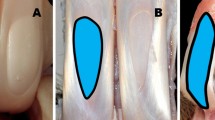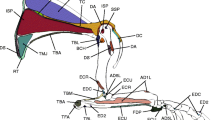Abstract
A tendon locking mechanism (TLM) in the digits of the feet has been described previously only in bats and birds. In bats, this mechanism typically consists of a patch of tuberculated fibrocartilage cells on the plantar surface of the proximal flexor tendons, and a corresponding plicated portion of the adjacent flexor tendon sheath. The two components mesh together like parts of a ratchet, locking the digit in a flexed position until the mechanism is disengaged. This system apparently allows bats to hang for long periods of time with reduced muscular activity. In this study, we document for the first time the presence of a similar tendon lock in dermopterans, an occurrence that provides additional support for the hypothesis that dermopterans and bats are sister taxa. The present work also includes observations on the morphology of the digital tendon system in chiropteran species not previously examined, including members of the Craseonycteridae, Mystacinidae and Kerivoulinae. Unlike other bats that have a TLM,Craseonycteris andKerivoula have a plicated proximal tendon sheath but lack distinct tubercles on the flexor tendon. This condition may be related to small body size or may represent an evolutionary intermediate between the presence of a well-developed TLM and the complete absence of this structure. Phyllostomids apparently lack the ratchet-like TLM typical of other bats, instead exhibiting modifications of the tendon sheath that may contribute to its function as a friction lock. Consideration of the distribution of TLM structures in the context of previous phylogenetic hypotheses suggests that a ratchet-type tendon lock was lost and reexpressed at least once and perhaps several times within Microchiroptera. The friction lock is an autapomorphy of Phyllostomidae.
Similar content being viewed by others
Literature Cited
Adkins, R. M., and Honeycutt, R. L. (1993). A molecular examination of archontan and chiropteran monophyly. In:Primates and Their Relatives in Phylogenetic Perspective, R. D. E. MacPhee, ed., pp. 227–249, Advances in Primatology Series, Plenum, New York.
Ammerman, L. K., and Hillis, D. M. (1992). A molecular test of bat relationships: Monophyly or diphyly?Syst. Biol. 41: 222–232.
Bailey, W. J., Slightom, J. L., and Goodman, M. (1992). Rejection of the “flying primate” hypothesis by phylogenetic evidence from the ε-globin gene.Science 256: 86–89.
Baker, R. J., Novacek, M. J., and Simmons, N. B. (1991). On the monophyly of bats.Syst. Zool. 40: 216–231.
Beard, K. C. (1993). Phylogenetic systematics of the Primatomorpha, with special reference to Dermoptera. In:Mammal Phylogeny: Placentals, F. S. Szalay, M. J. Novacek and M. C. McKenna, eds., pp. 129–150, Springer-Verlag, New York.
Benjamin, M., and Evans, E. J. (1990). Fibrocartilage.J. Anat. 117: 1–15.
Bennett, M. B. (1993). Structural modifications involved in the fore-and hind limb grip of some flying foxes (Chiroptera: Pteropodidae).J. Zool. London 229: 237–248.
Brooks, D. R., and McLennan, D. A. (1991).Phylogeny, Ecology, and Behavior: A Research Program in Comparative Biology, Chicago University Press, Chicago.
Gregory, W. K. (1910). The orders of mammals.Bull. Am. Mus. Nat. Hist. 27: 1–524.
Griffiths, T. A., and Smith, A. L. (1991). Systematics of emballonuroid bats (Chiroptera: Emballonuridae and Rhinopomatidae), based on hyoid morphology.Bull. Am. Mus. Nat. Hist. 206: 62–83.
Griffiths, T. A., Truckenbrod, A., and Sponholtz, P. J. (1992). Systematics of megadermatid bats (Chiroptera, Megadermatidae), based on hyoid morphology.Am. Mus. Novitates 3031: 1–21.
Hall, B. K. (1984). Developmental mechanisms underlying the formation of atavisms.Biol. Rev. 59: 89–124.
Hill, J. E., and Smith, J. D. (1984).Bats: A Natural History, University of Texas Press, Austin.
Johnson, J. I., and Kirsch, J. A. W. (1993). Phylogeny through brain traits: Interordinal relationships among mammals including Primates and Chiroptera. In:Primates and Their Relatives in Phylogenetic Perspective, R. D. E. MacPhee, ed., pp. 293–331, Advances in Primatology Series, Plenum Press, New York.
Kay, R. F., Thewissen, J. G. M., and Yoder, A. D. (1992). Cranial anatomy ofIgnacius graybullianus and the affinities of the Plesiadapiformes.Am. J. Phys. Anthropol. 89: 477–498.
Koopman, K. F. (1984). A synopsis of the families of bats, Part VII.Bat Res. News 25: 25–27.
Koopman, K. F. (1993). Order Chiroptera. In:Mammal Species of the World. A Taxonomic and Geographic Reference, 2nd ed., D. E. Wilson and D. M. Reeder, eds., pp. 137–241, Smithsonian Institution Press, Washington, DC.
Lauder, G. V. (1981). Form and function: Structural analysis in evolutionary biology.Paleobiology 7: 430–442.
Leche, W. (1886). Über die SäugethiergattungGaleopithecus: Eine morphologische Untersuchung.Köngl. Sv. Vet. Akademiens Handligar. 21: 4–97.
Lekagul, B., and McNeely, J. A. (1977).Mammals of Thailand, Sahakarnbhat, Bangkok.
Lester, K. S., Hand, S. J., and Vincent, F. (1988). Adult phyllostomid (bat) enamel by scanning electron microscopy—with a note on dermopteran enamel.Scanning Microscopy 2: 371–383.
Luckett, W. P. (1980). The use of fetal membrane data in assessing chiropteran phylogeny. In:Proceedings Fifth International Bat Research Conference, D. E. Wilson and A. L. Gardner, eds., pp. 245–265, Texas Tech Press, Lubbock.
Maddison, W. P., and Maddison, D. R. (1992).MacClade: Analysis of Phylogeny and Character Evolution, Version 3.0, Sinauer Associates, Sunderland, MA (computer program and associated documentation).
Nomina Anatomica Veterinaria (1983).International Commission on Veterinary Gross Anatomical Nomenclature of the World Association of Veterinary Anatomists, Ithaca, NY.
Novacek, M. J. (1980). Phylogenetic analysis of the chiropteran auditory region. In:Proceedings of the Fifth International Bat Research Conference, D. E. Wilson and A. L. Gardener, eds., pp. 317–330, Texas Tech University Press, Lubbock.
Novacek, M. J. (1986). The skull of leptictid insectivorans and the higher-level classification of eutherian mammals.Bull. Am. Mus. Nat. Hist. 183: 1–111.
Novacek, M. J. (1990). Morphology, paleontology, and the higher clades of mammals. In:Current Mammalogy, H. H. Genoways, ed., Vol. 2, pp. 507–543, Plenum Press, New York.
Novacek, M. J. (1992). Fossils, topologies, missing data, and the higher level phylogeny of eutherian mammals.Syst. Biol. 41: 58–73.
Novacek, M. J. (1994). Morphological and molecular inroads to phylogeny. InInterpreting the Hierarchy of Nature: From Systematic Patterns to Evolutionary Process Theories, L. Grande and O. Rieppel, eds., pp. 85–131, Academic Press, New York.
Novacek, M. J., and Wyss, A. R. (1986). Higher level relationships of the Recent eutherian orders: Morphological evidence.Cladistics 2: 257–287.
Nowak, R. M. (1991).Walker's Mammals of the World, Vol. 1, 5th ed., Johns Hopkins Press, Baltimore.
Patterson, C. (1982). Morphological characters and homology. In:Problems in Phylogenetic Reconstruction, K. A. Joysey and E. A. Friday, eds., Systematics Association Special Vol. 21, pp. 21–74, Academic Press, New York.
Pettigrew, J. D. (1991a). Wings or brain? Convergent evolution in the origins of bats.Syst. Zool. 40: 199–216.
Pettigrew, J. D. (1991b). A fruitful, wrong hypothesis? Response to Baker, Novacek, and Simmons.Syst. Zool. 40: 231–239.
Pettigrew, J. D. (1995). Flying primates: Crashed? Or crashed through? In:Ecology, Evolution and Behavior of Bats, P. A. Racey and S. M. Swift, eds., Symposium of the Zoological Society of London, Vol. 67, Oxford University Press, Oxford (in press).
Pettigrew, J. D., Jamieson, B. G. M., Robson, S. K., Hall, L. S., McAnally, K. I., and Cooper, H. M. (1989). Phylogenetic relations between microbats, megabats and primates (Mammalia: Chiroptera and Primates).Phil. Trans. R. Soc. Lond. B 325: 489–559.
Pierson, E. D. (1986).Molecular Systematics of the Microchiroptera: Higher Taxon Relationships and Biogeography, Ph.D. dissertation, University of California, Berkeley.
Quinn, T. H. (1993). A tendon locking mechanism (TLM) in the foot ofCynocephalus variegatus (Dermoptera).Am. Zool. 33(5): 133A.
Quinn, T. H., and Baumel, J. J. (1990). The digital tendon locking mechanism of the avian foot (Aves).Zoomorphology 109: 281–293.
Quinn, T. H., and Baumel, J. J. (1993). Chiropteran tendon locking mechanism.J. Morphol. 216: 197–208.
Ranvier, L. A. (1889). Sur les tendons des doigts chez les oiseaux.C.R. Acad. Sci. Paris 13: 167–169.
Rieppel, O. (1980). Homology, a deductive concept?Z. Zool. Syst. Evolutionsforsch. 18: 315–319.
Schaffer, J. (1903). Über die Sperrvorrichtung an den Zehen der Vögel.Z. Wiss. Zool. 73: 377–428.
Schaffer, J. (1905). Anatomisch-histologische Untersuchungen über den Bau der Zehen bei Fledermaüsen und einigen kletternden Säugetieren.Z. Wiss. Zool. 83: 231–284.
Schutt, W. A. (1992). Preliminary anatomical studies on the chiropteran hindlimb: Does the digital flexor retinaculum help bats get the hang of it?Bat Res. News 33: 74–75.
Schutt, W. A. (1993). Digital morphology in the Chiroptera: the passive digital lock.Acta Anat. 148: 219–227.
Shepherd, J. D. (1981).An Analysis of Proposed Avian Perching Mechanisms, Ph.D. dissertation, University of Connecticut, Storrs.
Simmons, N. B. (1993). The importance of methods: Archontan phylogeny and cladistic analysis of morphological data. In:Primates and Their Relatives in Phylogenetic Perspective, R. D. E. MacPhee, ed., pp. 1–61, Advances in Primatology Series, Plenum Press, New York.
Simmons, N. B. (1994). The case for chiropteran monophyly.Am. Mus. Novitates. 3103: 1–54.
Simmons, N. B. (1995). Bat relationships and the origin of flight. In:Ecology, Evolution and Behavior of Bats, P. A. Racey and S. M. Swift, eds., Symposium of the Zoological Society of London, Vol. 67, Oxford University Press, Oxford (in press).
Simmons, N. B., Novacek, M. J., and Baker, R. J. (1991). Approaches, methods, and the future of the chiropteran monophyly controversy: A reply to J. D. Pettigrew.Syst. Zool. 40: 239–244.
Smith, J. D. (1976). Chiropteran evolution. In:Biology of Bats of the New World Family Phyllostomatidae. Part 1, R. J. Baker, J. K. Jones, and D. C. Carter, eds., Special Publications of the Museum, Vol. 10, pp. 49–69, Texas Tech. University, Lubbock.
Stanhope, M. J., Czelusniak, J., Si, J.-S., Nickerson, J., and Goodman, M. (1992). A molecular perspective on mammalian evolution from the gene encoding interphotoreceptor retinoid binding protein.Mol. Phylo. Evol. 1: 148–160.
Stiassny, M. L. J. (1992). Atavisms, phylogenetic character reversals, and the origin of evolutionary novelties.Netherlands J. Zool. 42: 260–276.
Szalay, F. S., and Lucas, S. G. (1993). Cranioskeletal morphology of archontans, and diagnoses of Chiroptera, Volitantia, and Archonta. In:Primates and Their Relatives in Phylogenetic Perspective, R. D. E. MacPhee, ed., pp. 187–226, Advances in Primatology Series, Plenum Press, New York.
Van Valen, L. (1979). The evolution of bats.Evol. Theory 4: 104–121.
Vaughan, T. A. (1970). The muscular system. InBiology of Bats, Vol. I, W. A. Wimsatt ed., pp. 139–194, Academic Press, New York.
Vrana, P. B. (1994).Molecular Approaches to Mammalian Phylogeny, Ph.D. dissertation, Columbia University Graduate School of Arts and Sciences, New York.
Wake, D. B., and Larson, A. (1987). Multidimensional analysis of an evolving lineage.Science 238: 42–48.
Wible, J. R. (1993). Cranial circulation and relationships of the colugoCynocephalus (Dermoptera, Mammalia).Am. Mus. Novitates 3072: 1–27.
Wible, J. R., and Martin, J. R. (1993). Ontogeny of the tympanic floor and roof in archontans. In:Primates and Their Relatives in Phylogenetic Perspective, R. D. E. MacPhee, ed., pp. 111–148, Advances in Primatology Series, Plenum Press, New York.
Wible, J. R., and Novacek, M. J. (1988). Cranial evidence for the monophyletic origin of bats.Am. Mus. Novitates 2911: 1–19.
Author information
Authors and Affiliations
Rights and permissions
About this article
Cite this article
Simmons, N.B., Quinn, T.H. Evolution of the digital tendon locking mechanism in bats and dermopterans: A phylogenetic perspective. J Mammal Evol 2, 231–254 (1994). https://doi.org/10.1007/BF01464276
Issue Date:
DOI: https://doi.org/10.1007/BF01464276




